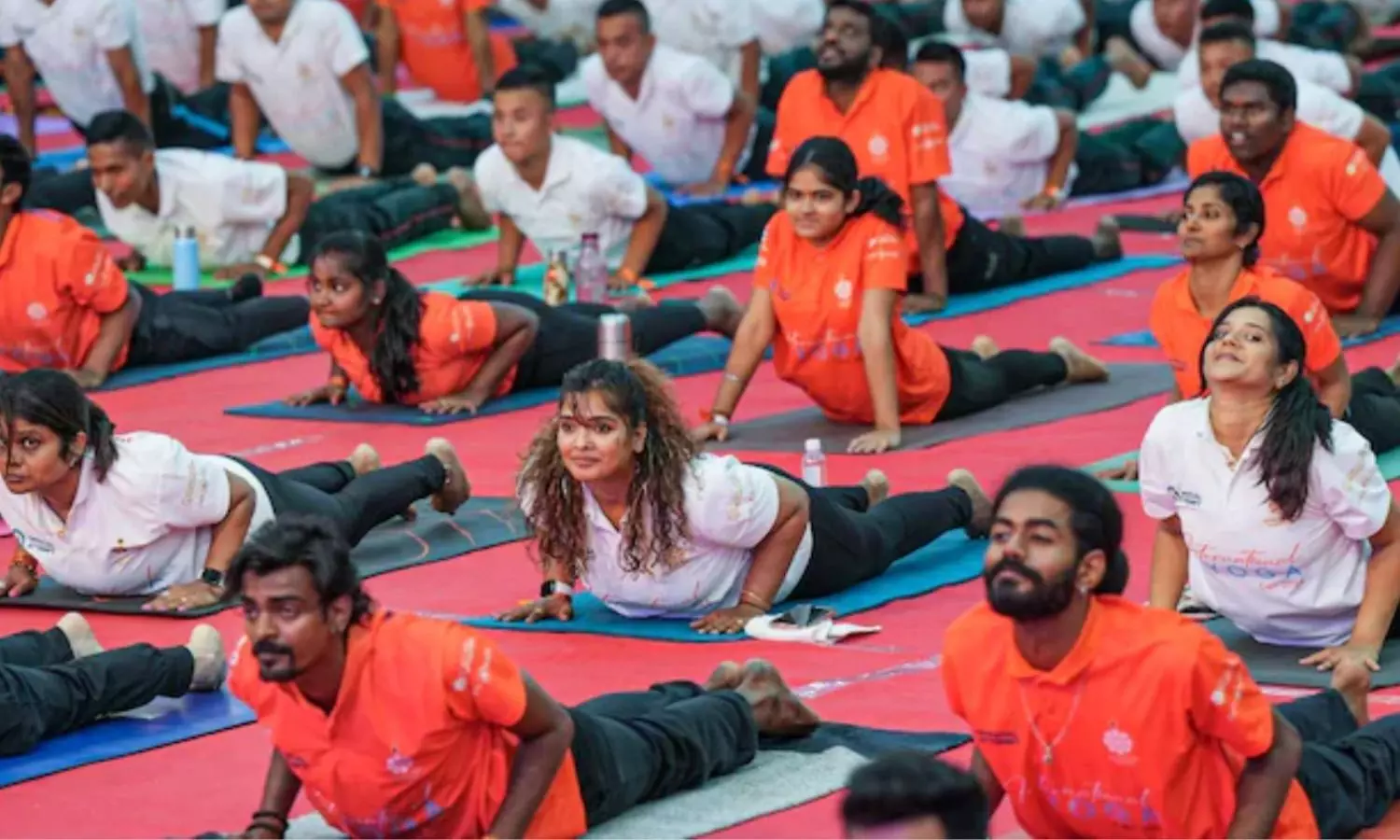GP- Article
From Yoga to Yasso Intervals: The Indianization of Olympic Training
India’s Olympic training is evolving — blending traditional yoga practices with modern Yasso interval workouts to create a holistic, performance-driven model rooted in Indian culture and sports science.

Yoga enthusiasts during an attempt to create the Guinness Book of World Record for most number of people performing the Surya Namaskar together during the 10th International Day of Yoga, in Bengaluru (PTI Photo)
India’s approach to sports training is undergoing a quiet revolution. For decades, the country’s athletic programs leaned heavily on imported models, borrowed fitness regimens, Western coaching philosophies, and foreign sports science methods.
But a new shift is underway, one that blends traditional Indian practices like yoga with globally recognized high-intensity workouts such as Yasso intervals.
This merging of heritage and innovation represents not only a cultural reclaiming of athletic identity but also a scientifically informed evolution in how Indian athletes prepare for the Olympics.
To explore the world of betting in athletics and various other sports, visit Khel Raja Sportsbook for more information.
Yoga’s Revival in Modern Sports Science
Yoga has long been one of India’s most powerful exports, celebrated worldwide for its benefits to flexibility, mindfulness, and mental resilience. Within the athletic sphere, its value extends far beyond stretching or relaxation.
A 2023 study published on PubMed Central notes that yoga contributes to improved muscle strength, recovery, and balance while significantly lowering stress levels among athletes. Indian sports institutions are beginning to take notice.
Programs within the Khelo India initiative and various national training centers have started integrating yoga into athlete conditioning, viewing it as a holistic approach to both body and mind.
Beyond the physiological effects, yoga offers a psychological foundation that aligns naturally with elite competition. Pranayama breathing techniques enhance lung capacity and control, while meditation sharpens focus during pressure-filled moments.
A study in The International Journal of Physical Education, Sports and Health found that athletes who practiced yoga alongside physical exercise showed measurable improvements in endurance compared to those following traditional gym routines alone.
This synergy is particularly relevant to Olympic-level training, where micro-gains in focus and recovery can determine podium finishes.
The cultural relevance of yoga also plays a subtle yet powerful role. Incorporating yoga into high-performance sport allows Indian athletes to ground themselves in a familiar philosophy of discipline and balance, creating a psychological edge.
In an environment often dominated by imported training frameworks, yoga provides both physical benefits and a rooted sense of belonging, something uniquely Indian, reasserted on the world’s most competitive stage.
The Science and Spirit of Yasso Intervals
In contrast to yoga’s meditative pace, Yasso intervals represent the high-octane side of modern training. Created by American running coach Bart Yasso, this method involves repeating 800-metre runs at a controlled but intense pace with equal recovery time.
While originally popular among marathoners, Yasso intervals have gained traction across disciplines as an efficient bridge between speed and endurance.
According to Verywell Fit, the structure of 10×800 m repetitions mirrors the demands of long-distance performance by stressing both aerobic and anaerobic systems in a time-efficient way.
Indian coaches have begun adopting variations of these intervals in their Olympic training camps, especially for middle- and long-distance runners.
The workouts are easily scalable, require minimal infrastructure, and can deliver measurable improvements in stamina, a key factor given the limited access many Indian athletes have to advanced facilities.
The emphasis on high-intensity repetition fits well with the Indian climate and athletic build, allowing athletes to develop race-specific conditioning even within local constraints.
However, the deeper significance of incorporating Yasso intervals lies in their compatibility with traditional Indian training philosophies.
The balance of controlled intensity and active recovery mirrors the rhythm of yoga practice itself, exertion followed by awareness, movement followed by stillness. In this way, what may appear as two opposing disciplines actually complement each other when applied together.
Explore Khel Raja Sportsbook for winning various exciting prizes in Indian Sports.
A Hybrid Model for India’s Olympic Future
The Indianization of Olympic training is not about rejecting Western sports science but redefining it through an Indian lens.
The fusion of yoga’s ancient wisdom with interval-based athletic conditioning represents a broader vision for how India can train smarter and more sustainably. It acknowledges the physiological realities of Indian athletes while embracing scientific rigor.
In practice, this integration might see an athlete starting the day with pranayama and mobility work, followed by track sessions structured around Yasso intervals to target cardiovascular endurance.
Recovery periods could include guided meditation or restorative yoga instead of passive rest. Over time, this kind of structured duality cultivates both resilience and adaptability, two traits that separate Olympic finalists from the rest of the field.
Challenges persist, of course. Indian athletes still face systemic issues like inadequate recovery monitoring, limited sports science staffing, and uneven access to high-performance facilities.
A landmark study in the Indian Journal of Physiology and Pharmacology highlighted that Indian runners’ VO₂ max values remain below global standards, underlining the need for more scientific conditioning methods.
But as more national coaches embrace the integration of mind-body practices with data-driven performance training, the results are beginning to show.
The cultural and physiological fusion embodied in the phrase “From Yoga to Yasso Intervals” represents a new era for Indian sport, one in which tradition and innovation move stride for stride.
The stillness of yoga and the intensity of track intervals may seem worlds apart, yet together they create a rhythm uniquely suited to India’s evolving Olympic ambitions.
As the country continues to redefine what high performance means, this hybrid approach might just become the blueprint for training the next generation of Indian champions.

